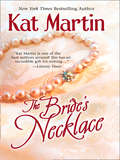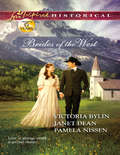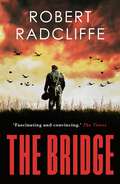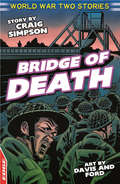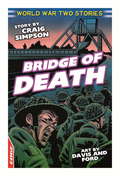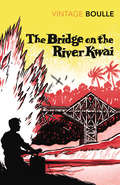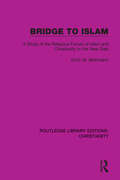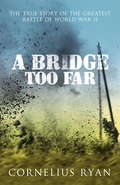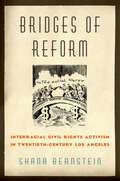- Table View
- List View
The Bride's Necklace: The Bride's Necklace The Devil's Necklace The Handmaiden's Necklace (The Necklace Trilogy #1)
by Kat MartinKnowing that she alone can protect her sister from the Baron Harwood, their lecherous stepfather, Victoria Temple Whiting snatches the family's heirloom necklace, believed to hold the power to bring great happiness or terrible tragedy, to pay for their escape to London.
Brides of Christ: Conventual Life in Colonial Mexico
by Asunción LavrinBrides of Christ invites the modern reader to follow the histories of colonial Mexican nuns inside the cloisters where they pursued a religious vocation or sought shelter from the world. Lavrin provides a complete overview of conventual life, including the early signs of vocation, the decision to enter a convent, profession, spiritual guidelines and devotional practices, governance, ceremonials, relations with male authorities and confessors, living arrangements, servants, sickness, and death rituals. Individual chapters deal with issues such as sexuality and the challenges to chastity in the cloisters and the little-known subject of the nuns' own writings as expressions of their spirituality. The foundation of convents for indigenous women receives special attention, because such religious communities existed nowhere else in the Spanish empire.
Brides of the West (Mills & Boon Love Inspired Historical): Josie's Wedding Dress Last Minute Bride Her Ideal Husband
by Victoria Bylin Pamela Nissen Janet DeanREUNION WESTERN-STYLE Josie’s Wedding Dress by Victoria Bylin
The Bride's Portion (Mills And Boon Vintage 90s Modern Ser.)
by Susan PaulThe Daughter of His Enemy Lillis of Wellewyn was the most beautiful woman Alexander had ever seen. A bride out of legend. Yet never could he claim her as his own, for he had vowed to let her go when the last of his people were free from her father's tyranny.
The Bride's Seduction: The Viscount's Betrothal / The Society Catch (regency, Book 54) / Practical Widow To Passionate Mistress / The Bride's Seduction / Married To A Stranger / A Most Unconventional Courtship (Mills And Boon Historical Ser.)
by Louise AllenA Marriage of Convenience?
The Bridge: A Journey Between Orient and Occident
by Geert Mak Sam GarrettIstanbul's Galata Bridge has spanned the Golden Horn since the sixth century AD, connecting the old city with the more Western districts to the north. But the bridge is a city in itself, peopled by merchants and petty thieves, tourists and fishermen, and at the same time a microcosmic reflection of Turkey as the link between Asia and Europe. Geert Mak introduces us to the cigarette vendors and the best pickpockets in Europe, to the pride of the cobbler and the tea-seller's homesickness, and interweaves their stories with vignettes illuminating the extraordinary history of Istanbul and Turkey. Charming and learned, The Bridge is a delightful book from the author of the acclaimed international bestseller In Europe.
The Bridge (The Airborne Trilogy #3)
by Robert Radcliffe'A born storyteller' SUNDAY TELEGRAPH. Young paratrooper Theo Trickey has had a remarkable war. Boy soldier, commando, intelligence officer – fighting from northern France to the African desert and in the mountains of Italy. He has already done more than should be asked of any man in war. But D-Day is looming and British intelligence have one more misson for Trickey: to negotiate with his extraordinary old acquaintance, General Erwin Rommel. There are rumours that Germany's greatest general wants to save the Fatherland by any means possible... The Bridge is the final instalment of Radcliffe's Airborne trilogy which tells the extraordinary story of a young soldier, a new regiment and how, together, they changed the course of a war.
The Bridge: The Life and Rise of Barack Obama
by David RemnickThe rise of Barack Obama is one of the great stories of this century: a defining moment for America, and one with truly global resonance. This is the book of his phenomenal journey to election. Through extensive on-the-record interviews with friends and teachers, mentors and disparagers, family members and Obama himself, David Remnick has put together a nuanced, unexpected and masterly portrait of the man who was determined to become the first African-American President. Most importantly, The Bridge argues that Obama imagined and fashioned an identity for himself against the epic drama of race in America. In a way that Obama's own memoirs cannot, it examines both the personal and political elements of the story, and gives shape not only to a decisive period of history, but also to the way it crucially influenced, animated and motivated a gifted and complex man.
The Bridge: The Building of the Verrazano-Narrows Bridge
by Gay TaleseToward the end of 1964, the Verrazano Narrows Bridge-linking the New York City boroughs of Brooklyn and Staten Island with New Jersey-was completed. Fifty years later, it remains an engineering marvel. At 13,700 feet (more than two and a half miles), it is still the longest suspension bridge in the United States and the sixth longest in the world. Gay Talese, then early in his career at the New York Times, closely followed the construction, and soon after the opening of this marvel of human ingenuity and engineering, he chronicled the human drama of its completion-from the construction workers high on the beams to the backroom dealing that displaced whole neighborhoods to make way for the bridge. Now in a new, beautifully packaged edition featuring dozens of breathtaking photos and architectural drawings, The Bridge remains both a riveting narrative of politics and courage and a demonstration of Talese's consummate skills as a reporter and storyteller. His memorable narrative will help celebrate the bridge's fiftieth anniversary and captivate a new generation of readers.
Bridge across the Bosporus: The Foreign Policy of Turkey
by Ferenc A. VáliOriginally published in 1971. With Atatürk's guiding reforms, Turkey underwent a sweeping modernization of the country's administration. More specifically, by adopting the Latin alphabet, secularizing the country's governance, and importing European laws and jurisprudence, Mustafa Kemal Atatürk effectively reformed the Republic of Turkey into a secular, modern nation-state. In doing so, he introduced a number of foreign policy commitments. Ferenc A. Váli examines the flexibility of Turkey's foreign commitments in light of the country's modernization; depending on the circumstance, Turkey's foreign policy has wavered between Western alliance and neutrality. Examining Turkey's foreign policy in the twentieth century, Váli provides historical background for Turkey's transition form an empire to a nation-state. Váli also assesses Turkey's relations with NATO, Western allies, Russia, the Baltic States, and the Middle East. For his research, Váli conducted interviews with officials of the Turkish Ministry for Foreign Affairs, political party leaders, academics, journalists, and members of diplomatic missions.
A Bridge between Conceptual Frameworks: Sciences, Society and Technology Studies (History of Mechanism and Machine Science #27)
by Raffaele PisanoThis book analyzes scientific problems within the history of physics, engineering, chemistry, astronomy and medicine, correlated with technological applications in the social context. When and how is tension between disciplines explicitly practised? What is the conceptual bridge between science researches and the organization of technological researches in the development of industrial applications?The authors explain various ways in which the sciences allowed advanced modelling on the one hand, and the development of new technological ideas on the other hand. An emphasis on the role played by mechanisms, production methods and instruments bestows a benefit on historical and scientific discourse: theories, institutions, universities, schools for engineers, social implications as well.Scholars from different traditions discuss the emergency style of thinking in methodology and, in theoretical perspective, aim to gather and re-evaluate the current thinking on this subject. It brings together contributions from leading experts in the field, and gives much-needed insight into the subject from a historical point of view. The volume composition makes for absorbing reading for historians, philosophers and scientists.
Bridge of Death: Bridge Of Death (EDGE: World War Two Short Stories #1)
by Craig SimpsonIt's D-Day, 6th June 1944. Ten minutes after midnight. A small British force is flying over Occupied France on what is virtually a suicide mission - they must capture a bridge before German forces guarding it can blow it up. There's no room for error. They must cast fear aside in this race against time, told from both a British and German perspective. This title is published by Franklin Watts EDGE, which produces a range of books to get children reading with confidence. EDGE - for books kids can't put down.
Bridge of Death: Bridge Of Death (EDGE: World War Two Short Stories)
by Craig SimpsonIt's D-Day, 6th June 1944. Ten minutes after midnight. A small British force is flying over Occupied France on what is virtually a suicide mission - they must capture a bridge before German forces guarding it can blow it up. There's no room for error. They must cast fear aside in this race against time, told from both a British and German perspective. This title is published by Franklin Watts EDGE, which produces a range of books to get children reading with confidence. EDGE - for books kids can't put down.
The Bridge of San Luis Rey: Curriculum Unit (Penguin Modern Classics)
by Thornton WilderAn ancient bridge collapses over a gorge in Peru, hurling five people into the abyss. It seems a meaningless human tragedy. But one witness, a Franciscan monk, believes the deaths might not be as random as they appear. Convinced that the disaster is a punishment sent from Heaven, the monk sets out to discover all he can about the travellers. The five strangers were connected in some way, he thinks. There must be a purpose behind their deaths. But are their lost lives the result of sin? ... Or of love?
The Bridge On The River Kwai
by Pierre BoulleThe Bridge on the River Kwai tells the story of three POWs who endure the hell of the Japanese camps on the Burma-Siam railway - Colonel Nicholson, a man prepared to sacrifice his life but not his dignity; Major Warden, a modest hero, saboteur and deadly killer; Commander Shears, who escaped from hell but was sent back. Ordered by the Japanese to build a bridge, the Colonel refuses, as it is against regulations for officers to work with other ranks. The Japanese give way but, to prove a point of British superiority, construction of the bridge goes ahead - at great cost to the men under Nicholson's command.
Bridge to Islam: A Study of the Religious Forces of Islam and Christianity in the Near East
by Erich W. BethmannOriginally published in 1953, Bridge to Islam is a detailed study of the beliefs of Muhammad and his followers, exploring the relationship between the world of Islam and that of Christianity. Drawing attention to the common beliefs between Islam and Christianity, the book examines the relationship between these two prominent religions and poses the argument that it is only through a proper appreciation of the differences in spiritual attitudes that a bridge of understanding and knowledge can be built between them. It traces the religious histories of different countries in the Middle East and assesses the position of Islam and Christianity in each one. Bridge to Islam will appeal to those with an interest in the history of Christianity, the history of Islam, religious studies, and the Middle East.
Bridge to Islam: A Study of the Religious Forces of Islam and Christianity in the Near East
by Erich W. BethmannOriginally published in 1953, Bridge to Islam is a detailed study of the beliefs of Muhammad and his followers, exploring the relationship between the world of Islam and that of Christianity. Drawing attention to the common beliefs between Islam and Christianity, the book examines the relationship between these two prominent religions and poses the argument that it is only through a proper appreciation of the differences in spiritual attitudes that a bridge of understanding and knowledge can be built between them. It traces the religious histories of different countries in the Middle East and assesses the position of Islam and Christianity in each one. Bridge to Islam will appeal to those with an interest in the history of Christianity, the history of Islam, religious studies, and the Middle East.
A Bridge to the Sky: The Arts of Science in the Age of 'Abbas Ibn Firnas
by Glaire AndersonIn times of widespread Islamophobia, there is an understandable motivation for constructing scientific achievement as a counternarrative in popular discourse about Islam. Yet doing so has tended to impose an anachronistic conception of "science" onto pre-modern practices while also obscuring wider views of the intellectual, philosophical, and particularly the material context of medieval scientific achievement. An exemplary case study for this phenomenon is the figure of 'Abbas Ibn Firnas (d. 887), a celebrated early scientist, C?rdoban courtier, and polymath. Ibn Firnas is best known today for conducting an early aeronautics experiment, which was commemorated by NASA. Some historians have called it the first successful human flight. The earliest and fullest account of Ibn Firnas' career in the Umayyad court includes the aeronautics experiment, and a great deal more on his achievements in the arts and design but has yet to receive sustained scholarly attention. That account, as preserved in a volume of the Muqtabas of Ibn Hayyan (d. 1076), the Cordoban court chronicle, presents Ibn Firnas as both the leading intellectual of early Islamic Iberia and as a pioneering figure in the design and construction of the court's first fine scientific instruments and space of scientific visualization. A Bridge to the Sky reconstructs the account of Ibn Firnas' career to explore the exact sciences, design, and making as interconnected intellectual practices during the first flowering of the Islamic scientific revolution. Glaire D. Anderson deftly weaves analyses of the Arabic texts alongside the striking contemporaneous visual evidence, including some of the earliest surviving Islamic scientific instruments and illustrated treatises that are, as argued here, also works of art. A Bridge to the Sky thus offers both an intellectual biography of the intriguing figure of Ibn Firnas alongside an exploration of the culture of scientific learning in Umayyad al-Andalus. As a novel examination of the social significance of science, design and craftsmanship in medieval Iberia and the Islamic lands during the "classical" period of Islamic civilization, A Bridge to the Sky opens new avenues of study in the fields of medieval Islamic studies and art history, visual and material culture studies, and history of science.
A Bridge to the Sky: The Arts of Science in the Age of 'Abbas Ibn Firnas
by Glaire AndersonIn times of widespread Islamophobia, there is an understandable motivation for constructing scientific achievement as a counternarrative in popular discourse about Islam. Yet doing so has tended to impose an anachronistic conception of "science" onto pre-modern practices while also obscuring wider views of the intellectual, philosophical, and particularly the material context of medieval scientific achievement. An exemplary case study for this phenomenon is the figure of 'Abbas Ibn Firnas (d. 887), a celebrated early scientist, C?rdoban courtier, and polymath. Ibn Firnas is best known today for conducting an early aeronautics experiment, which was commemorated by NASA. Some historians have called it the first successful human flight. The earliest and fullest account of Ibn Firnas' career in the Umayyad court includes the aeronautics experiment, and a great deal more on his achievements in the arts and design but has yet to receive sustained scholarly attention. That account, as preserved in a volume of the Muqtabas of Ibn Hayyan (d. 1076), the Cordoban court chronicle, presents Ibn Firnas as both the leading intellectual of early Islamic Iberia and as a pioneering figure in the design and construction of the court's first fine scientific instruments and space of scientific visualization. A Bridge to the Sky reconstructs the account of Ibn Firnas' career to explore the exact sciences, design, and making as interconnected intellectual practices during the first flowering of the Islamic scientific revolution. Glaire D. Anderson deftly weaves analyses of the Arabic texts alongside the striking contemporaneous visual evidence, including some of the earliest surviving Islamic scientific instruments and illustrated treatises that are, as argued here, also works of art. A Bridge to the Sky thus offers both an intellectual biography of the intriguing figure of Ibn Firnas alongside an exploration of the culture of scientific learning in Umayyad al-Andalus. As a novel examination of the social significance of science, design and craftsmanship in medieval Iberia and the Islamic lands during the "classical" period of Islamic civilization, A Bridge to the Sky opens new avenues of study in the fields of medieval Islamic studies and art history, visual and material culture studies, and history of science.
A Bridge Too Far: The true story of the Battle of Arnhem
by Cornelius RyanArnhem 1944: the airborne strike for the bridges over the Rhine.The true story of the greatest battle of World War II and the basis of the 1977 film of the same name, directed by Richard Attenborough.The Battle of Arnhem, one of the most dramatic battles of World War II, was as daring as it was ill-fated. It cost the Allies nearly twice as many casualties as D-Day. This is the whole compelling story, told through the vast cast of characters involved. From Dutch civilians to British and American strategists, its scope and ambition is unparalleled, superbly recreating the terror and suspense, the heroism and tragedy of this epic operation.'I know of no other work of literature of World War II as moving, as awesome and as accurate in its portrayal of human courage.' - General James A Gavin
Bridges: A History of the World's Most Spectacular Spans
by Judith DupréFrom New York Times best-selling author Judith Dupré comes a revised and updated edition of Bridges, her magnificent chronological tour of the world's most significant and eye-popping spans. Covering thousands of years of architectural history, each bridge is gorgeously photographed "elevating the landmarks from mode of transportation to works of art" (Bustle). Technological advances, structural daring, and artistic vision have propelled the evolution of bridge design around the world. This visual history of the world's landmark bridges has been thoroughly revised and updated since its initial publication twenty-five years ago, and now showcases well-known classics as well as modern innovators. Bridges featured include: The Brooklyn Bridge (New York)Danyand-Kunshan Grand Bridge (China)Gateshead Millennium Bridge (England)The Golden Gate Bridge (San Francisco)Zakim Bridge (Boston)Including all-new photographs and the latest cutting edge work from today's international superstars of architecture and engineering, Bridges covers two-thousand years of technological and aesthetic triumphs, making it the most thorough, authoritative, and gorgeous book on the subject-as dramatic in presentation as the structures it celebrates. Breathtaking photographs capture the bridges' details as well as their monumental scale; architectural drawings and plans invite you behind the scenes as new bridges take shape; and lively commentary on each structure explores its importance and places it in historical context. Throughout, informative profiles, features, and statistics make Bridges an invaluable reference as well as a visual feast.
Bridges: A History of the World's Most Spectacular Spans
by Judith DupréFrom New York Times best-selling author Judith Dupréomes a revised and updated edition of Bridges, her magnificent chronological tour of the world's most significant and eye-popping spans. Covering thousands of years of architectural history, each bridge is gorgeously photographed "elevating the landmarks from mode of transportation to works of art" (Bustle). Technological advances, structural daring, and artistic vision have propelled the evolution of bridge design around the world. This visual history of the world's landmark bridges has been thoroughly revised andupdated since its initial publication twenty-five years ago, and now showcases well-known classics as well as modern innovators. Bridges featured include:The Brooklyn Bridge (New York)Dany and-Kunshan Grand Bridge (China)Gateshead Millennium Bridge (England)The Golden Gate Bridge (San Francisco)Zakim Bridge (Boston) Including all-new photographs and the latest cutting edgework from today's international superstars of architecture and engineering, Bridges covers two-thousand years of technological and aesthetic triumphs, making it the most thorough, authoritative, and gorgeous book on the subject-as dramatic in presentation as the structures it celebrates. Breathtaking photographs capture the bridges' details as well as their monumental scale; architectural drawings and plans invite you behind the scenes as new bridges take shape; and lively commentary on each structure explores its importance and places it in historical context. Throughout, informative profiles, features, and statistics make Bridges an invaluable reference as well as a visual feast.
Bridges (Shire Library)
by Richard HaymanFrom the monumental splendour of Tower Bridge and the august span at Westminster to the engineering masterpieces at Ironbridge and the Forth, bridges comprise some of the most recognisable landmarks in Britain. Whether the smallest arch or the largest overpass, each has a rich architectural, economic, social and sometimes even religious history. This beautifully illustrated introduction by Richard Hayman explains how piety built and maintained bridges in the Middle Ages; how economic forces inspired a new generation of road bridges in the eighteenth century, such as the Menai Bridge in North Wales, and how technological prowess gave us soaring Victorian railway viaducts and the concrete road bridges of the twentieth century.
Bridges (Shire Library)
by Richard HaymanFrom the monumental splendour of Tower Bridge and the august span at Westminster to the engineering masterpieces at Ironbridge and the Forth, bridges comprise some of the most recognisable landmarks in Britain. Whether the smallest arch or the largest overpass, each has a rich architectural, economic, social and sometimes even religious history. This beautifully illustrated introduction by Richard Hayman explains how piety built and maintained bridges in the Middle Ages; how economic forces inspired a new generation of road bridges in the eighteenth century, such as the Menai Bridge in North Wales, and how technological prowess gave us soaring Victorian railway viaducts and the concrete road bridges of the twentieth century.
Bridges of Reform: Interracial Civil Rights Activism in Twentieth-Century Los Angeles
by Shana BernsteinIn her first book, Shana Bernstein reinterprets U.S. civil rights activism by looking at its roots in the interracial efforts of Mexican, African, Jewish, and Japanese Americans in mid-century Los Angeles. Expanding the frame of historical analysis beyond black/white and North/South, Bernstein reveals that meaningful domestic activism for racial equality persisted from the 1930s through the 1950s. She stresses how this coalition-building was facilitated by the cold war climate, as activists sought protection and legitimacy in this conservative era. Emphasizing the significant connections between ethno-racial communities and between the United States and world opinion, Bridges of Reform demonstrates the long-term role western cities like Los Angeles played in shaping American race relations.
